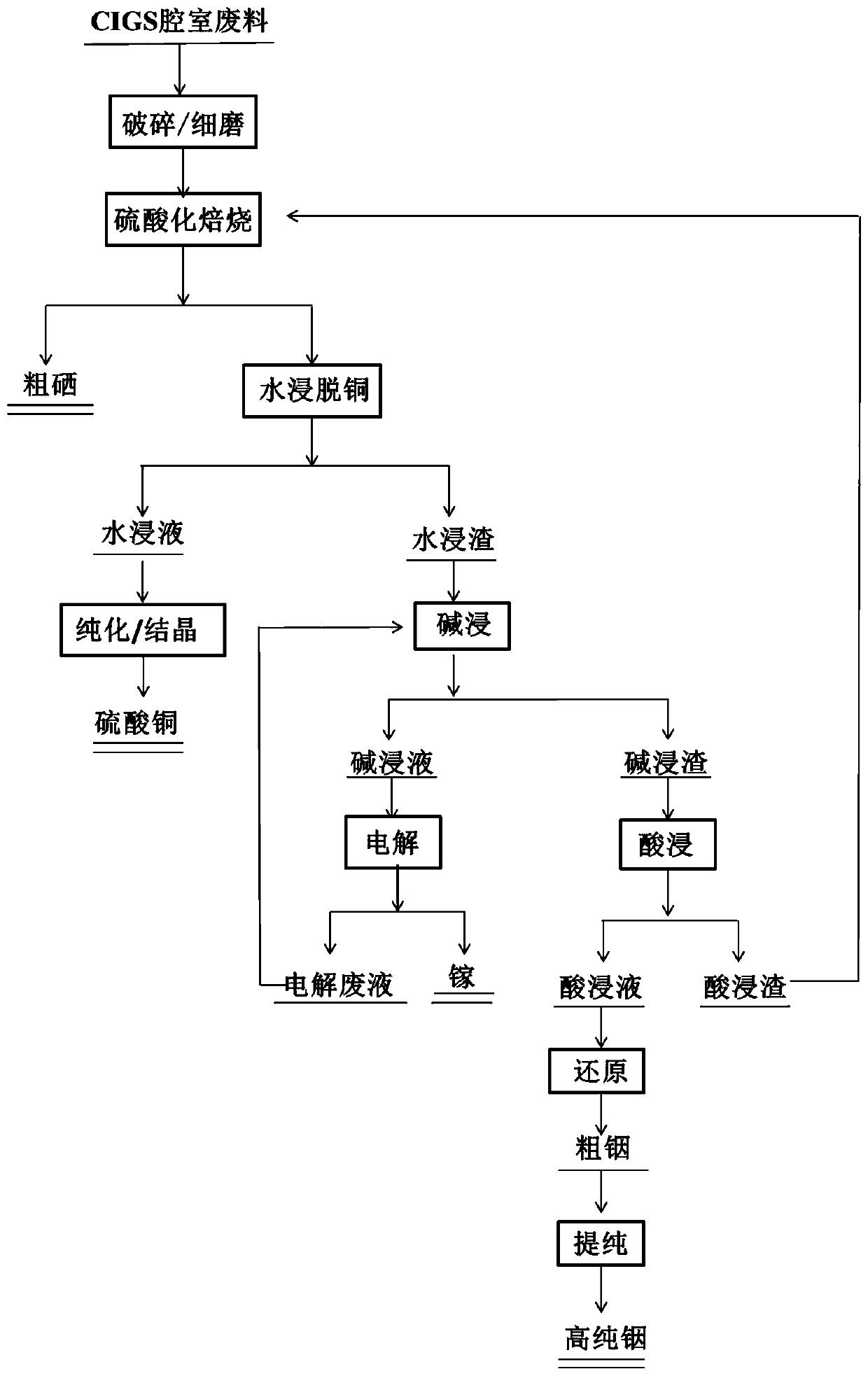Method for recycling copper indium gallium selenide from copper indium gallium selenide solar thin film battery waste
A technology of solar thin film and copper indium gallium selenide, which is applied in the field of secondary utilization of resources, can solve problems such as complex operation process, incomplete separation, and long process, and achieve the effect of simple process flow, meeting environmental protection requirements, and low equipment investment
- Summary
- Abstract
- Description
- Claims
- Application Information
AI Technical Summary
Problems solved by technology
Method used
Image
Examples
Embodiment 1
[0042] Such as figure 1 As shown, the implementation steps of this embodiment include: taking 50g of crushed and finely ground CIGS waste, adding 98% concentrated sulfuric acid with a mass fraction of 100kg / t-waste, and then performing sulfation roasting at a roasting temperature of The calcined material was obtained at 300°C and the calcining time was 2h, and crude selenium was separated from it. The purity of the crude selenium was 98.2%. The roasting material from which crude selenium is separated is subjected to water leaching under normal pressure. The leaching temperature is 50℃, the leaching time is 2h, the leaching liquid-solid ratio is 3:1ml / g, and the stirring speed is 400rpm to obtain the water leaching and water leaching. Scum. The water immersion liquid is purified and crystallized to obtain copper sulfate products. The water leaching residue is washed, the washing liquid is returned to the water leaching process, and then the water leaching residue is alkali lea...
Embodiment 2
[0044] The implementation steps of this embodiment include: taking 50g of crushed and finely ground CIGS waste, adding 98% concentrated sulfuric acid, the use amount of concentrated sulfuric acid is 700kg / t-waste, and then performing sulfation roasting at a roasting temperature of 200°C. The roasting time is 5h, so as to obtain the roasted material, from which crude selenium is separated, and the purity of crude selenium is 98.6%. The roasting material from which crude selenium is separated is subjected to water leaching under normal pressure, the leaching temperature is 20°C, the leaching time is 6h, the leaching liquid-to-solid ratio is 1:1ml / g, and the stirring speed is 200rpm to obtain the leaching liquid and the leaching residue. Purification / crystallization treatment of the leachate obtained by water leaching can obtain copper sulfate product. The water leaching residue is washed, the washing liquid is returned to the water leaching process, and then the water leaching re...
Embodiment 3
[0046] The implementation steps of this embodiment include: taking 50g of crushed and finely ground CIGS waste, adding 98% of concentrated sulfuric acid, the usage amount of concentrated sulfuric acid is 600kg / t-waste, and then performing sulfation roasting at 700°C. The roasting time is 0.5h, so as to obtain the roasted material, from which crude selenium is separated. The crude selenium purity is 99.1%. The roasted material after the crude selenium has been separated is leached in water under normal pressure. The leaching temperature is 20℃, the leaching time is 6h, the leaching liquid-to-solid ratio is 10:1ml / g, and the stirring speed is 200rpm to obtain the water immersion and water. Leaching residue. The water immersion liquid is purified and crystallized to obtain copper sulfate products. The water leaching residue is washed, and the washing liquid is returned to the water leaching process, and then the water leaching residue is subjected to atmospheric alkaline leaching...
PUM
| Property | Measurement | Unit |
|---|---|---|
| concentration | aaaaa | aaaaa |
| concentration | aaaaa | aaaaa |
| concentration | aaaaa | aaaaa |
Abstract
Description
Claims
Application Information
 Login to View More
Login to View More - R&D
- Intellectual Property
- Life Sciences
- Materials
- Tech Scout
- Unparalleled Data Quality
- Higher Quality Content
- 60% Fewer Hallucinations
Browse by: Latest US Patents, China's latest patents, Technical Efficacy Thesaurus, Application Domain, Technology Topic, Popular Technical Reports.
© 2025 PatSnap. All rights reserved.Legal|Privacy policy|Modern Slavery Act Transparency Statement|Sitemap|About US| Contact US: help@patsnap.com

